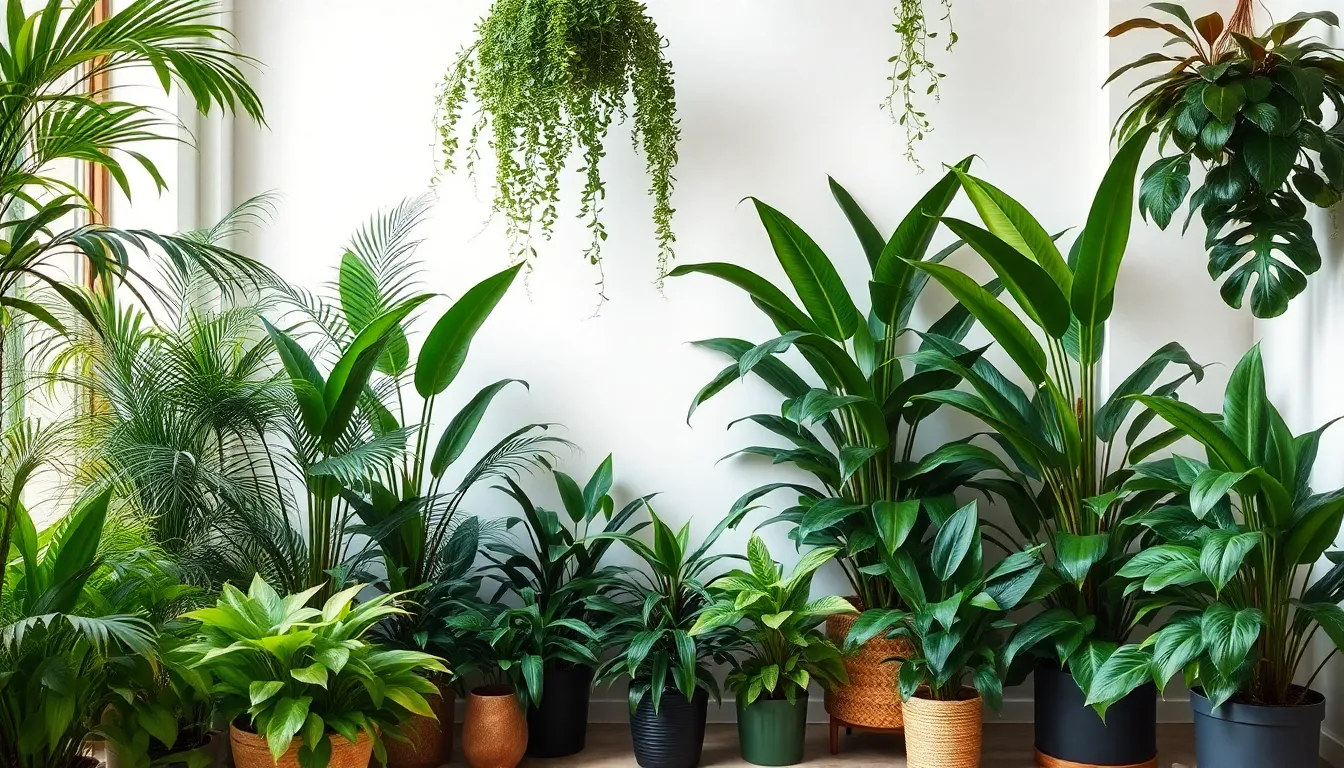Table of Contents
ToggleWhen it comes to transforming a space, foliage arrangement is the unsung hero of interior design. Picture this: a room bursting with life, where vibrant greens and playful textures dance together in perfect harmony. It’s not just about adding plants; it’s about creating an atmosphere that breathes freshness and style.
Overview Of Foliage Arrangement
Foliage arrangement plays a crucial role in enhancing the aesthetics of any space. It focuses on the strategic placement of plants to create balance and harmony within the design. Plants can vary in size, shape, and color, offering numerous possibilities for creative expression.
When selecting foliage, consider the room’s lighting conditions. Light requirements can influence plant health, affecting overall impact on the environment. Low light spaces benefit from plants like pothos or snake plants, while brighter areas suit species like succulents and fiddle-leaf figs.
Additionally, the arrangement of plants contributes to visual interest. Grouping plants in odd numbers tends to create a more natural look. Varying heights also adds dimension, allowing smaller plants to complement taller ones effectively.
Texture provides another essential element in foliage arrangement. Mixing smooth and rough-leaved plants creates contrast, drawing the eye and enhancing tactile appeal. Combining colors and textures elevates visual stimulation, making spaces more inviting.
Maintenance must also be a consideration in choosing foliage. Some plants require more care than others, influencing their suitability for specific environments. Selecting low-maintenance varieties often benefits those with a busy lifestyle, ensuring greenery remains vibrant without extensive effort.
Lastly, seasonal changes can impact foliage arrangement. Incorporating seasonal plants augments aesthetic diversity, aligning with changing decor preferences throughout the year. This adaptability makes foliage arrangement not only practical but also a dynamic aspect of interior design.
Importance Of Foliage Arrangement

Foliage arrangement plays a crucial role in enhancing both the aesthetic and functional aspects of interior spaces.
Aesthetic Appeal
Visual appeal increases significantly with the inclusion of well-arranged foliage. Plants add vibrancy and life to a room, promoting a welcoming atmosphere. Unique textures and varying shades of green create a striking contrast against neutral backgrounds. Grouping plants in odd numbers further enhances visual interest by creating natural focal points. Incorporating seasonal varieties introduces diversity and keeps the arrangement fresh, adapting easily to changing decor trends. Engaging the eye through different heights in plant arrangements captures attention and transforms any space into a vibrant oasis.
Functional Benefits
Foliage arrangement contributes significantly to improved air quality. Plants filter pollutants, thus contributing to a healthier living environment. Strategic placement in areas with optimal light ensures the plants thrive while enhancing room dynamics. Low-maintenance species fit well in busy households, limiting the need for extensive care. Further benefits include natural humidification, which improves comfort levels, particularly in dry indoor conditions. Properly arranged foliage can also serve as a sound barrier, reducing noise levels and promoting tranquility in crowded areas. The functional advantages of nature within living spaces support overall well-being and comfort.
Techniques For Foliage Arrangement
Foliage arrangement techniques enhance visual appeal and support plant health. Utilizing effective methods can significantly elevate the ambiance of any space.
Layering Plants
Layering plants creates depth and dimension in arrangements. Placing taller plants at the back or center anchors the display, while medium and shorter varieties fill the front. This arrangement allows each plant to showcase its unique features, promoting visibility. Additionally, considering foliage textures helps create a rich visual tapestry, as contrasting leaves add interest. Experimenting with different leaf shapes and sizes contributes to an engaging look. Grouping plants by height aids in achieving a cohesive design, drawing attention to the overall arrangement.
Color Coordination
Color coordination plays a vital role in foliage arrangement. Selecting plants with complementary hues fosters a harmonious atmosphere. For instance, pairing deep greens with vibrant reds or yellows creates visual excitement. Further, choosing plants with variegated leaves introduces subtle variations, enhancing dynamic appeal. Creating sections with specific color themes can evoke different moods within a space. Also, incorporating seasonal blooms adds bursts of color that refresh the arrangement throughout the year. By prioritizing color combinations, the overall aesthetic becomes striking and cohesive, contributing to a well-designed environment.
Common Mistakes In Foliage Arrangement
Foliage arrangement can greatly influence a room’s aesthetic. However, several common mistakes can undermine its impact.
Overcrowding
Overcrowding foliage often overwhelms spaces and detracts from visual appeal. Placing too many plants in one area stifles their growth and can create a chaotic look. Each plant needs room to breathe and showcase its features. Generally, a good rule involves spacing plants to highlight individual characteristics. Allowing distance facilitates proper air circulation and light access. Strategically arranging plants not only enhances overall beauty but also promotes healthy growth. Aim for fewer plants with more intention, letting each flourish in its own space.
Ignoring Scale
Ignoring scale in foliage arrangement seriously misaligns with design principles. When plants vary widely in size, they disrupt harmony and balance within the space. Taller plants should anchor arrangements while shorter varieties fill gaps for visual coherence. Emphasizing a mix of heights creates interest and draws attention to different areas. Each plant contributes to a cohesive look when considered alongside surrounding decor. As a guideline, use the space’s dimensions to dictate plant selection and arrangement. Respecting these proportions positively impacts overall design and atmosphere.
Foliage arrangement is a powerful tool in interior design that elevates both aesthetics and well-being. By thoughtfully selecting and positioning plants, one can create a vibrant and inviting atmosphere. The strategic use of height, color, and texture not only enhances visual appeal but also promotes harmony within a space.
Embracing seasonal changes and low-maintenance varieties ensures that the arrangement remains fresh and manageable. With careful consideration of plant health and placement, it’s possible to transform any environment into a lush sanctuary. Ultimately, the right foliage arrangement can breathe life into a room while providing functional benefits that enhance everyday living.




